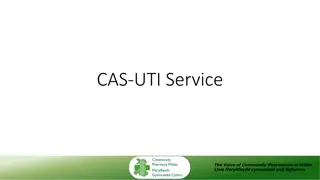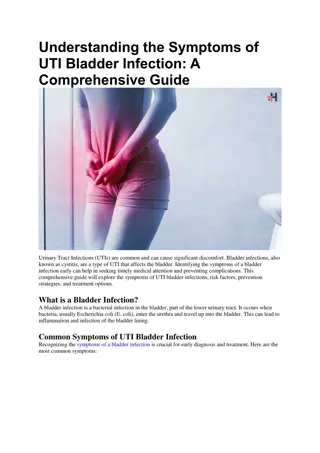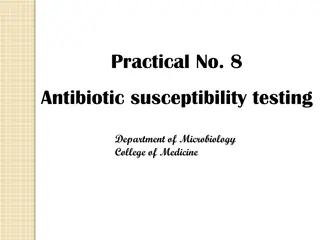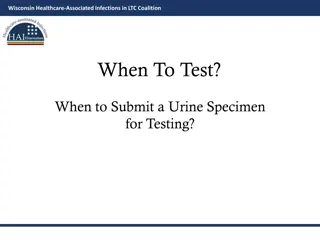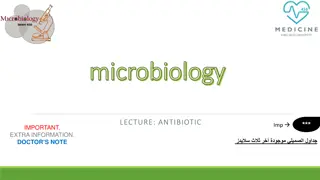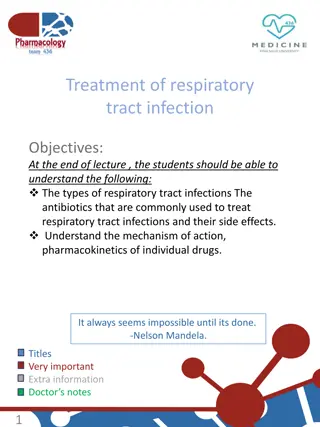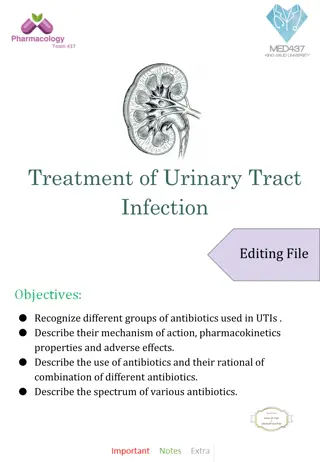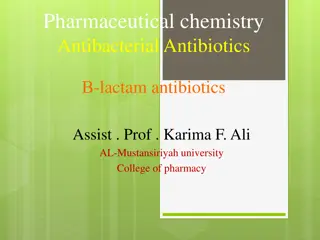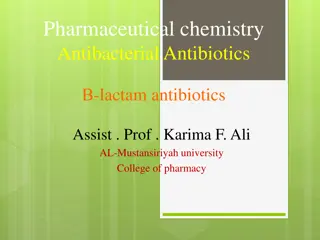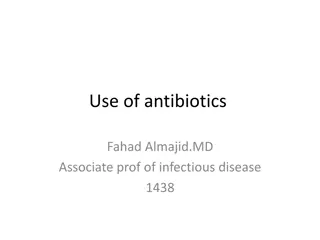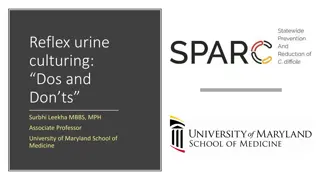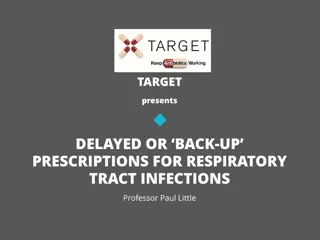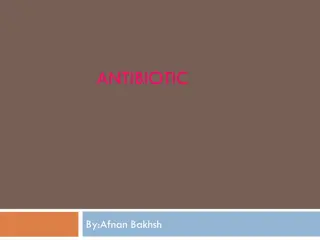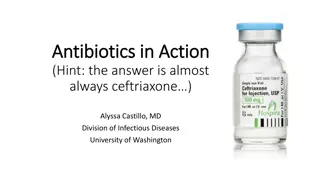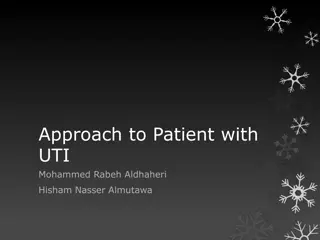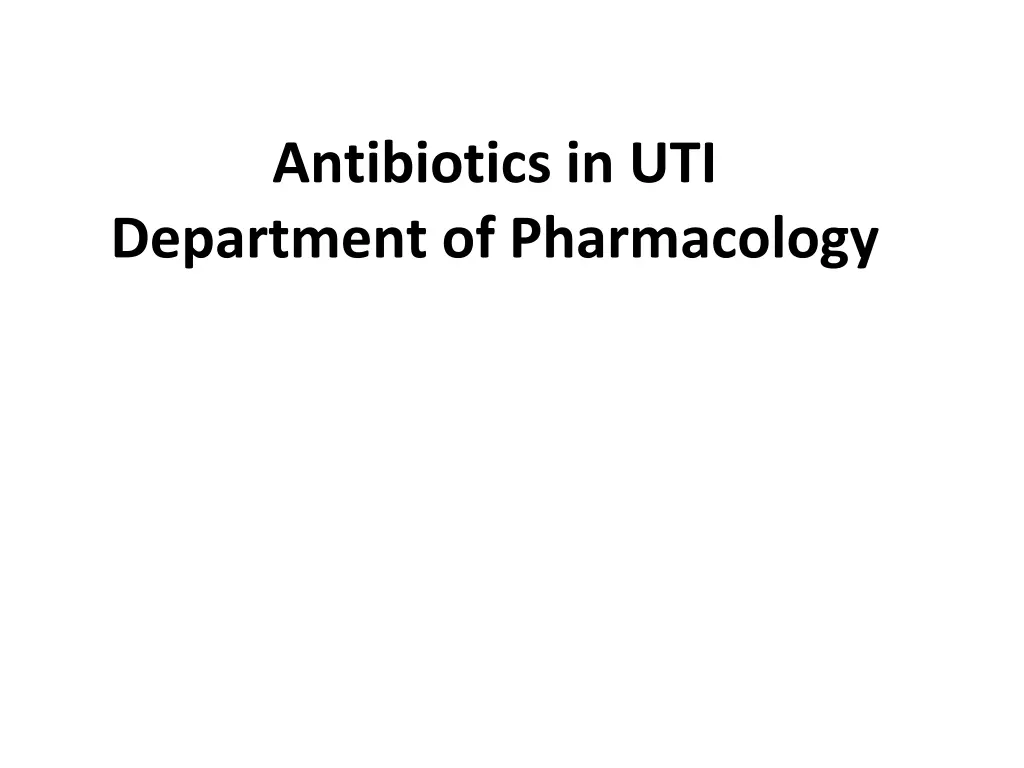
Understanding Urinary Tract Infections and Antibiotic Treatment
Explore the causes and bacterial culprits behind urinary tract infections (UTIs), along with differentiating between simple and complicated UTIs. Learn about common antibiotics used for UTI treatment, such as Co-trimoxazole and Nitrofurantoin, and the importance of proper antibiotic selection for effective treatment.
Download Presentation

Please find below an Image/Link to download the presentation.
The content on the website is provided AS IS for your information and personal use only. It may not be sold, licensed, or shared on other websites without obtaining consent from the author. If you encounter any issues during the download, it is possible that the publisher has removed the file from their server.
You are allowed to download the files provided on this website for personal or commercial use, subject to the condition that they are used lawfully. All files are the property of their respective owners.
The content on the website is provided AS IS for your information and personal use only. It may not be sold, licensed, or shared on other websites without obtaining consent from the author.
E N D
Presentation Transcript
Antibiotics in UTI Department of Pharmacology
Urinary tract infections(UTIs) It is the 2ndmost common infection ( after RTI s). It is often associated with some obstruction of the flow of urine. It is more common in women more than men 30:1 (Why?). Incidence of UTI increases in old age(10% of men & 20% of women).
What are the causes of UTIs Normally urine is sterile. Bacteria comes from digestive tract to opening of the urethra. Obstruction of the flow of urine(e.g. kidney stone) Enlargement of prostate gland in men(common cause) Catheters placed in urethra and bladder. Not drinking enough fluids. Waiting too long to urinate. Large uterus in pregnant women. Poor toilet habits(wiping back to front for women) Disorders that suppress the immune system(diabetes & cancer chemotherapy).
Bacteria responsible of urinary tract infections Gm- bacteria (most common): E.coli (approx. 80% of cases) Proteus mirabilis Klebsiella Pseudomonas aeruginosa Gm+ bacteria : Staphylococcus Saprophyticus(Approx. 20%) Mycoplasma, Chlamydia trachomatis & N. gonorrhea (limited to urethra, unlike E.coli may be sexually transmitted)
Urinary tract infections can be: Simple: Infections do not spread to other parts of the body and go away readily with treatment ( Due to E.coli in most cases). Complicated: Infections Spread to other parts of the body and resistant to many antibiotics and more difficult to cure.{Due to hospital- acquired bacteria(E.coli, Klebsiella,, Proteus, Pseudomonas, enterococci, staphylococci)}
Treatment of UTIs Antibiotics: Co-trimoxazole(SMX/TMP) ),p.o. Nitrofurantoin,p.o. Tetracyclines, e.g. Doxycycline,p.o. Aminoglycosides, e.g. gentamicin cephalosporins(e.g.ceftriaxone&ceftazidime Quinolones, e.g. ciprofloxacin,p.o.
Co-trimoxazole (Bactrim, Septra) Sulfamethoxazole- Trimethoprim (SMX) (TMP) Alone, each agent is bacteriostatic Together they are bactericidals(synergism) The optimal ratio of TMP to SMX in vivo is 1:20 (formulated 5(SMX):1(TMP); 800mg SMX+160mg TMP; 400 mg SMX+ 80 mg TMP; 40 mg SMX+8 mg TMP).
MECHANISM OF ACTION P-Aminobenzoic Acid Dihydropteroate Sulfonamides synthetase Dihydrofolate Dihydrofolate reductase Tetrahydrofolate Trimethoprim Nucleic acid synthesis
Absorption,metabolism&Excetion Sulfonamides Mainly given orally Rapidly absorbed from stomach and small intestine. Widely distributed to tissues and body fluids ( including CNS, CSF ), placenta and fetus. Absorbed sulfonamides bind to serum protein( approx. 70% ). Metabolized in the liver by the process of acetylation. Eliminated in the urine, partly as such and partly as acetylated derivative.
Trimethoprim ( TMP ) Usually given orally, alone or in combination with SMX Well absorbed from the gut Widely distributed in body fluids & tissues ( including CSF ) More lipid soluble than SMX Protein bound ( approx.40 % ) 60% of TMP or its metabolite is excreted in the urine TMP concentrates in the prostatic fluid.
ADVERSE EFFECTS 1.Gastrointestinal- Nausea, vomiting 2. Allergy 3. Hematologic a) Acute hemolytic anemia a) hypersensitvity b) G6PD deficiency b) Megaloblastic anemia due to TMP. 4. Drug interactions Displace bilirubin- if severe kernicterus Potentiate warfarin, oral hypoglycemics.
CONTRAINDICATIONS 1. Pregnancy 2. Nursing mother 3. Infants under 6 weeks 4. Renal or hepatic failure 5. Blood disorders
Nitrofurantoin Antibacterial Spectrum: Effective against E. coli and Staph. saprophyticus, but other common UT gm- bacteria may be resistant.
Mechanism of action of nitrofurantoin Sensitive bacteria converts the drug to an active agent that inhibits various enzymes and damages DNA.
Pharmacokinetics of nitrofurantoin Absorption is complete after oral use Metabolized (75%)& excreted so rapidly that no systemic antibacterial action is achieved. Concentrated in the urine(25% of the dose excreted unchanged) It turns urine to a dark orange-brown.
Adverse effects of nitrofurantoin GI disturbances: bleeding of the stomach,nausea, vomiting and diarrhea(must be taken with food). Headache and nystagmus. Hemolytic anaemia(G6PD deficiency) Containdications: Pts with G6PD deficiency Neonates Pregnant women(after 38 wks of pregnancy)
Therapeutic Uses of nitrofurantoin It is used as urinary antiseptics . Its usefulness is limited to lower UTI s & cannot be used for upper UT or systemic infections. Dose: 50-100 mg, po q 6h/7 days. Long acting: 100mg twice daily.
Tetracyclines (e.g. Doxycycline) It is a long acting tetracycline Mechanism of action Inhibit protein synthesis by binding reversibly to 30 s subunit
Doxycycline ( Cont. ) Pharmacokinetics Usually given orally Absorption is 90-100% Absorbed in the upper s. intestine & best in absence of food Food & di & tri-valent cations ( Ca, Mg, Fe, AL) impair absorption Protein binding 40-80 % Distributed well, including CSF Cross placenta and excreted in milk Largely metabolized in the liver and excreted by kidneys
Doxycycline ( Cont. ) Side effects 1. nausea, vomiting ,diarrhea & epigastric pain(give with food) 2. Thrombophlebitis i.v 3. Hepatic toxicity ( prolonged therapy with high dose ) 4. Brown discolouration of teeth children 5. Deformity or growth inhibition of bones children 6. Phototoxicity 7. Vertigo 8. Superinfections.
Contraindications of doxycycline Pregnancy Breast feeding Children(below 10 yrs)-Binds to calcium in bone and teeth 22
Therapeutic Uses of Doxycycline Treatment of UTI s due to Mycoplasma & Chlamydia, 100 mg p.o bid for 7 days. Prostatitis
Aminoglycosides e.g. GENTAMICIN,i.m,i.v. Bactericidal antibiotics Inhibits protein synthesis by binding to 30S ribosomal subunits. Poorly absorbed orally(highly charged). Only active against gram negative aerobic organisms.
Gentamicin(CONT) Excreted unchanged in urine More active in alkaline medium Adverse effects : Ototoxicity Nephrotoxicity Neuromuscular blocking effect
Therapeutic uses of Gentamicin in UTIs Severe infections caused by gram negative organisms (pseudomonas or enterobacter). Also combined with other antibiotics
Cephalosporins (Detail was explained in respiratory lec.) 3rdgeneration cephalosporins Ceftriaxone & Ceftazidime Mainly effective against gm- bacteria. Acts by inhibition of cell wall synthesis Bactericidal They are given parenterally Given in severe / complicated UTIs & acute prostatitis
Fluroquinolones e.g. ciprofloxacin Active against gram negative aerobic organisms. Mechanism of action Inhibits DNA gyrase enzyme Clinical use UTIscaused by multidrug resistance organisms as pseudomonas. Prostatitis ( acute / chronic )
Adverse effects Nausea , vomiting , diarrhea CNS effects ( confusion, insomnia, headache, anxiety). Damage of growing cartilage(arthropathy) Phototoxicity(avoid excessive sunlight)

